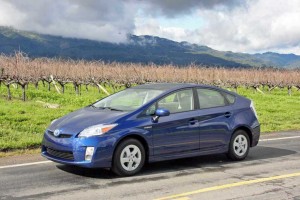
The 2010 Toyota Prius. Long the world's best-selling hybrid, but there are storm clouds gathering as the hybrid market collapses.
It’s hard to argue with success, and since making its American debut, in 1999, the Toyota Prius has been unquestionably the most successful offering in the fast-growing hybrid segment. This time, last year, the Japanese automaker could barely keep up with demand. In an industry where dealers normally keep an average 50 to 60 days worth of inventory on hand, Toyota retailers were averaging something closer to five hours.
Demand was growing so fast that the Japanese maker scrapped plans to produce its Highlander SUV at an all-new plant, in Mississippi, opting instead to build more of the distinctive, 4-door hybrids. Not a bad idea considering dealers were readily demanding – and receiving premiums that could run several thousand dollars over sticker for each Prius they could cajole out of the factory.
But something’s happened, in recent months. Prius sales, which topped 20,000, last June, have plunged to barely 6,000 a month since the beginning of the year. That new plant, down South? The mega-million-dollar project has been put on hold. Sure, the recession has a lot to do with it, and so does the plunge in fuel prices, which are now averaging less than half their mid-2008 peak. Further complicating matters: the arrival of an array of new hybrid-electric vehicles, or HEVs, ranging from the Ford Fusion to Honda’s completely-redesigned Insight, which is hitting showrooms at a rock-bottom $20,000.
Don’t expect Toyota to walk away from the Prius, as it celebrates its 10th anniversary, here in the United States. Far from it. But the Japanese maker – which has been hit unexpectedly hard by the recession – is keeping its corporate fingers crossed as it launches the third-generation Prius hybrid, which will roll into dealer showrooms this spring.
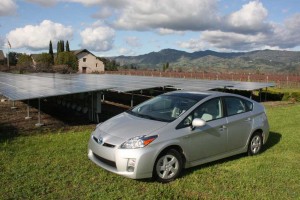
The '10 Prius offers an array of accessories, including a solar roof panel that can power the ventilation system on a hot day.
Those who’ve come to love the futuristically nerdy Prius shape will readily recognize the 2010 edition. As before, the mantra was “outside minimum, inside maximum,” explained project director Akihiko Otsuka, which translates into a mid-size cabin somehow shoehorned into a compact exterior that is just a wee bit bigger than the Gen-2 Prius in most key dimensions.
The basic shape has been subtly refined, starting with a smaller grille and a larger, lower intake meant to appear more sporty. The fog lamps, meanwhile, are now integrated into the front fascia. A distinctive touch is the sky blue background that shadows the Toyota emblem. It will reappear across the maker’s hybrid line-up.
On the whole, all the styling changes are functional, not just cosmetic. Squared-off edges, for example, yield better aerodynamics, as does the longer rear spoiler, while moving the peak of the crescent roofline back four inches yields improved rear seat headroom.
Even the move to LED brake lights was a practical decision, explains Chris Risdon, of the University of Toyota, reducing energy consumption by 80% compared to the old halogen bulbs – energy that now can be used to further improve fuel economy. All in all, says Risdon, “There’s a huge stack of pieces put together to make for lower fuel consumption.”
While mileage clearly mattered, so did comfort and convenience. As already noted, there’s more rear headroom, and a generally less cramped feeling within the cabin, with more leg and hip room, both front and back. There’s an extra half cubic foot of cargo space – now 10.24 cf with the rear seats up – and an additional 2 feet of cargo hidden in a compartment somehow squeezed in between the trunk load floor and the spare tire.
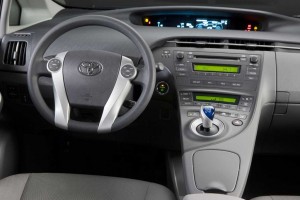
Big changes have been made to improve both the aesthetics and ergonomics of the 2010 Prius.
Both aesthetically and ergonomically, the 2010 Prius is a definite improvement, as well, with a much more attractive instrument panel with gauges and read-outs that are no longer designed solely for the computer geek or the eco-fanatic who only wants to know how much fuel the Hybrid Synergy Drive is saving every second. The navigation system has been relocated and is now far easier to track without taking your eyes off the road for long. A new Multi-Info Display, or MID, can be programmed to highlight a range of vehicle data, as well as simple matters, such as the time.
A couple changes deserve special attention: the addition of a new steering wheel that now tilts and telescopes, and the relocation of the shifter to a more conventional position on the center console. We just never can get comfortable with a handle thrusting out of the instrument panel. Kudos, also, for the improved seating, which offers more fore-and-aft travel and a lot better bolstering. A long drive is no longer an invitation for a visit to the chiropractor.
Let’s face it: Toyota is a company that loves its geeks, both those that design its products, and those who buy them. Sometimes that means the automaker forgets about the more traditional joys of owning a car, such as handling and acceleration, but if you like bells-and-whistles, it’s always there for you…and the 2010 Prius is no exception.
Among the numerous new features, many are geared to enhancing safety, such as the new Lane Departure Warning system, which alerts a driver who may drift across the double-yellow line. There’s Dynamic Radar Cruise, which maintains a safe distance from the vehicle ahead – and which also alerts the driver in the event of a likely collision. A back-up camera is standard, as you’d expect.
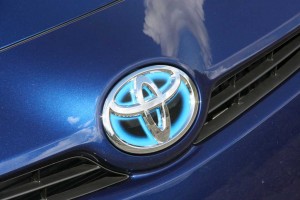
A new look for the Toyota badge debuts on the 2010 Prius and will be used on all future hybrid models.
After a lukewarm reception for its automatic parking system, first introduced on the top-line Lexus LS sedan, the modified and seemingly easier-to-use Intelligent Park Assist has landed as another of the numerous high-tech Prius options. That list also includes a solar roof panel that powers the ventilation system to keep the cabin cool on hot days.
One of the more intriguing features is dubbed Touch Tracer Display, and it helps you find the right one out of the many steering wheel-mounted sensors you might be looking for. As your fingers do the walking, an image appears on a representative map that pops up on the instrument panel showing precisely which button you’re touching.
All these geek treats are fun and often quite functional, but let’s face it, if you’re buying a hybrid, what matters most is the gasoline-electric powertrain. And so, Toyota claims it has revised a significant 90 percent of its trademark Hybrid Synergy Drive. In reality, it’s undergone a number of improvements, though there are no real breakthroughs. Changes include a switch to a beltless drive system powering accessories, which means less frictional losses. The various electronic systems are smaller and lighter.
One of the most significant revisions is counterintuitive, with the displacement of the new Atkinson Cycle I-4 engine beefed up to 1.8 liters, compared to the older, 1.5-liter engine. In reality, that’s a sound solution for the American market, where the Prius is likely to spend a fair amount of time being driven at highway speeds. The bigger engine thus doesn’t have to work quite as hard under conditions where it’s traditionally been a drag on fuel economy.
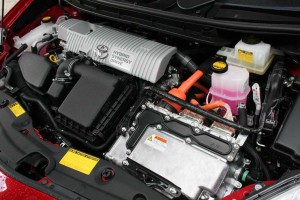
Same changes are counterintuitive, like the bigger 1.8-liter I-4 engine, which actually improves highway mileage.
Remember, the electric portion of an HEV’s powertrain only recaptures energy during braking and coasting, not cruising. And it only helps the gasoline engine during launch or passing maneuvers. On the highway, it’s the I-4 pulling the weight.
The results? The outgoing Prius yielded 48 mpg in the EPA’s City driving cycle, but just 45 on the Highway. The ’10’s numbers are 51 and 48, with a Combined Cycle rating of 50 mpg. Modest gains, perhaps, but enough to add up to a lot of saved fuel over the life of the vehicle.
You can now switch the Hybrid Synergy Drive into a variety of different modes. EV Mode will opt for running solely on battery power, where possible, for up to a mile, though it takes a light foot to stay there. Then there’s Eco-Mode, which is intended to take the lead out of a lead-footed driver by, among other things, changing the responsiveness of the throttle.
Power Mode will, among other things, improve the time for a 30 to 50 mph acceleration from 5.81 seconds to 4.11 seconds, according to Toyota’s stopwatch. But 0 to 60 times remain the same, at an acceptable but not overwhelming 9.8 seconds. That’s down from 10.2 seconds on the original Prius.
In real world driving, the new Prius does everything it can to maximize mileage at every opportunity. Rebels that we are, my driving partner and I decided to “counter-program” the little grudge match Toyota challenged us to – asking us to beat the mileage of their chief engineer on a mixed, City/Highway loop through California’s scenic Napa Valley. It took tremendous effort and some of the most egregiously bad driving behavior imaginable to get a final number of “just” 26.8 mpg. Colleagues were routinely generating numbers in the 60 to 70 range – equally unrealistic, but clearly suggesting that this generation Prius should come a lot closer to meeting its EPA rating than the Gen 1 and 2 models, which routinely fell short.
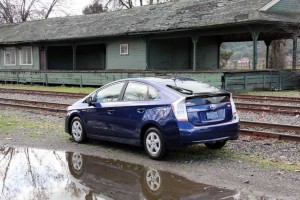
The peak of the roof has been moved back four inches to yield more headroom for the rear seats.
Napa’s a place we normally love to go for testing sports cars, with its challengingly windy lanes and steep hills. Once we got past watching the video mileage display and started focusing on driving dynamics, we recognized some major improvements over earlier versions of the Prius. The ’10 is definitely more fun to drive, but let’s face it, the Prius’ very raison d’etre is to be a mileage champ, not a sports car. Steering remains numb and there’s notable body roll in hard corners.
As to price, well, we’ll have to wait for the final numbers, though the basic sedan is likely to come in somewhere around $30,000, we anticipate. That’s a good deal considering all the gear the “base” car is laden with – and we’d expect to see it push into the low- to mid-$40,000 range when you add everything from auto parking to solar roof.
Honda will target Prius with the new Insight, and at a mere $20,000, it will definitely catch the eye of some potential Toyota customers. To be clear, the Honda is smaller and its hybrid drivetrain is less sophisticated; it doesn’t have an EV mode, for one thing. But mileage-minders are often wallet-watchers, as well, so Toyota will have to be wary.
Nonetheless, there’s a lot to like about the 2010 Toyota Prius. It’s got more room, more features, and gets more mileage. And barring some unexpected surprises, that’s an equation that should help it remain the world’s top-selling HEV.
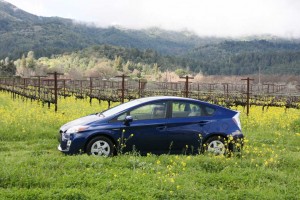
- How green is my Prius? Will the third-generation hybrid help Toyota maintain its reputation as the industry’s environmental leader?
What “green” technology will dominate tomorrow’s automotive market?
